
Bihar Sharif is the headquarters of Nalanda district and the fifth-largest sub-metropolitan area in the eastern Indian state of Bihar. Its name is a combination of two words: Bihar, derived from vihara, also the name of the state; and Sharif. The city is a hub of education and trade in southern Bihar, and the economy centers around agriculture supplemented by tourism, the education sector and household manufacturing. The ruins of the ancient Nalanda Mahavihara, a UNESCO World Heritage Site, are located near the city.
This article lists monuments and sites of historic importance in Odisha, India.

Udayagiri and Khandagiri Caves, formerly called Kattaka Caves or Cuttack caves, are partly natural and partly artificial caves of archaeological, historical and religious importance near the city of Bhubaneswar in Odisha, India. The caves are situated on two adjacent hills, Udayagiri and Khandagiri mentioned as Kumari Parvata in the Hathigumpha inscription. They have a number of finely and ornately carved caves built during the 1st century BCE. It is believed that most of these caves were carved out as residential blocks for Jaina monks during the reign of King Kharavela. Udayagiri means "Sunrise Hill" and has 18 caves while Khandagiri has 15 caves.
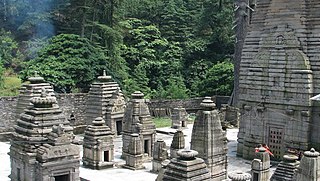
Jageshwar Temples, also referred to as Jageswar Temples or Jageshwar Valley Temples, are a group of 125 ancient Hindu temples dated between 7th and 14th century near Almora, in the Himalayan Indian state of Uttarakhand. The valley has a number of temple clusters such as the Dandeshwar and Jageshwar sites. Some locations have attracted construction of new temples through the 20th-century. Together these clusters over the valley consist of over 200 structural temples built from cut stone. Many are small, while a few are substantial. They predominantly illustrate North Indian Nagara style of architecture with a few exceptions that show South and Central Indian style designs, many are dedicated to god Shiva, while others in immediate vicinity are dedicated to god Vishnu, Shakti goddesses and Surya traditions of Hinduism.

Airavatesvara Temple is a Hindu temple of Dravidian architecture located in Kumbakonam, Thanjavur District in the South Indian state of Tamil Nadu. This temple, built by Chola emperor Rajaraja II in the 12th century CE is a UNESCO World Heritage Site, along with the Brihadeeswara Temple at Thanjavur, the Gangaikondacholisvaram Temple at Gangaikonda Cholapuram that are referred to as the Great Living Chola Temples.
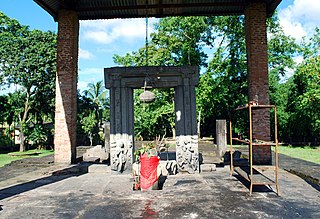
Da Parbatia is a small village very close to west Tezpur, in the Indian State of Assam. In the village there are significant architectural remnants of an ancient temple of the 6th century overlying the ruins of another Shiva temple built of bricks during the Ahom period. Archaeological excavations done here in 1924 have unearthed a sixth-century antiquity in the form of a stone door frame with extensive carvings. The ruins of the temple built during the Ahom period are built over the ancient temple's foundations and are in the form of a stone paved layout plan of the sanctum sanctorum and a mandapa. This complex is under the jurisdiction of the Archaeological Survey of India and its importance and notability is recorded under the Ancient Monuments and Archaeological Sites and Remains Act 1958.
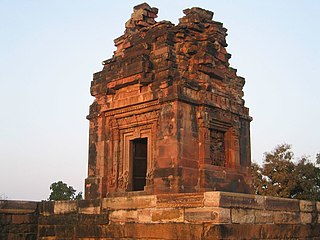
The Dashavatara Temple is an early 6th century Vishnu Hindu temple located at Deogarh, Uttar Pradesh which is 125 kilometers from Jhansi, in the Betwa River valley in northern-central India. It has a simple, one cell square plan and is one of the earliest Hindu stone temples still surviving today. Built in the Gupta Period, the Dashavatara Temple at Deogarh shows the ornate Gupta style architecture.

Brihadishvara Temple, locally known as Thanjai Periya Kovil, and also called Rajarajeswaram, is a Shaivite Tamizh temple dedicated to Shiva located in South bank of Cauvery river in Thanjavur, Tamil Nadu, India. It is one of the largest Hindu temples and an exemplary example of a fully realized Tamil architecture. It is called as Dakshina Meru. Built by Chola emperor Rajaraja I between 1003 and 1010 AD, the temple is a part of the UNESCO World Heritage Site known as the "Great Living Chola Temples", along with the Chola dynasty era Gangaikonda Cholapuram temple and Airavatesvara temple that is about 70 kilometres (43 mi) and 40 kilometres (25 mi) to its northeast respectively.

The Bateshwar Hindu temples are a group of nearly 200 sandstone Hindu temples and their ruins in north Madhya Pradesh in post-Gupta, early Gurjara-Pratihara style of North Indian temple architecture. It is about 35 kilometres (22 mi) north of Gwalior and about 30 kilometres (19 mi) east of Morena town. The temples are mostly small and spread over about 25 acres (10 ha) site. They are dedicated to Shiva, Vishnu and Shakti - representing the three major traditions within Hinduism. The site is within the Chambal River valley ravines, on the north-western slope of a hill near Padavali known for its major medieval era Vishnu temple. The Bateshwar temples were built between the 8th and the 10th-century. The site is likely named after the Bhuteshvar Temple, the largest Shiva temple at the site. It is also referred to as Batesvar temples site or Batesara temples site.

Deogarh is a village in Lalitpur district of the Indian state of Uttar Pradesh. It is located on the right bank of Betwa River and to the west of Lalitpur hills. It is known for Gupta monuments and for many ancient monuments of Hindu and Jain origins inside and outside the walls of the fort.

The Martand Sun Temple is a Hindu temple located near the city of Anantnag in Jammu and Kashmir, India. It dates back to the 8th century AD and was dedicated to Surya, the chief solar deity in Hinduism; Surya is also known by the Sanskrit-language synonym Martand. The temple was destroyed by the Shah Miri dynasty in the 15th century, on the orders of the erstwhile Muslim ruler of Kashmir, Sikandar Shah Miri.
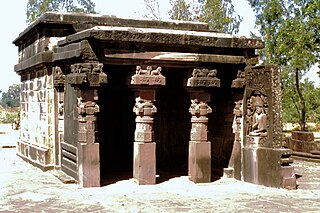
Tigawa is a village in Indian state of Madhya Pradesh and an archaeological site with a complex of about 36 Hindu temple ruins. Of these, the small but important and ancient Kankali Devi Temple is in good condition, and is usually dated to about 400-425 CE. Unless another building is mentioned, references to "the temple" below refer to this.

The Kedareshvara temple is located in the town of Balligavi, near Shikaripura in the Shimoga district of Karnataka state, India. Dotted with centres of learning (agrahara), Balligavi was an important city during the 11th - 12th century Western Chalukya rule. The term Anadi Rajadhani used in medieval inscriptions to describe this town tells a tale of great antiquity. Art historian Adam Hardy classifies the style involved in the construction of the temple as "Later Chalukya, non mainstream, relatively close to mainstream". He dates the temple to late 11th century, with inscriptional evidence of additions made up to 1131, by the Hoysalas during their control over the region. The building material used is soapstone. The Archaeological Survey of India classifies the style of architecture as distinctly Hoysala. The Hoysala ruling family was during this period a powerful feudatory of the imperial Western Chalukya Empire, gaining the trappings of independence only from the period of King Vishnuvardhana. The temple is protected as a monument of national importance by the Archaeological Survey of India.
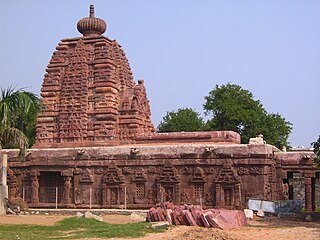
Alampur Navabrahma Temples are a group of nine early badami Chalukyan Hindu temples dated between 7th-century and 9th-century that are located at Alampur in Telangana,India, near the meeting point of Tungabhadra River and Krishna River at the border of Andhra Pradesh. They are called Nava-Brahma temples though they are dedicated to Shiva. They exemplify early North Indian Nagara style architecture with cut rock as the building block.The temples of alampur resembles the style of pattadakal,aihole style as they were karnata dravida,vesara style native to Karnataka.

The Nagareshvara Temple, also called the Aravattarukmbhada Gudi is a 12th-century Western Chalaukya construction. Bankapura is located in the Haveri District of Karnataka state, India. According to the Archaeologist Henry Cousens (1854–1933), during medieval times, the Bankapura fort was considered one of the most important fortifications in the Karnataka region. According to Cousens, the temple suffered much damage when Bankapura fell to the armies of Firoz Shah Bahamani in 1406 CE and later again when it was occupied by the Bijapur Sultan Adil Shah. According to the writings of Farishtah, the Sultan "ordered a superb temple within the fort to be destroyed". However, despite much pillage, the large temple with its majestic "great" hall (mantapa) still retains some of its original beauty. That the temple was built in honor of the Hindu god Shiva comes from two short inscriptions in the temple which begin with a salutation to "Shambu". There are other inscriptions in the temple, two of which are dated 1138 CE and one dated 1091 that record grants to the god "Nagaresvaradeva". The temple is protected as a monument of national importance by the Archaeological Survey of India.

Teli ka Mandir, also known as Telika Temple, is a Hindu temple located within the Gwalior Fort in Madhya Pradesh, India. Dedicated to Shiva, Vishnu and Matrikas, it has been variously dated between the early 8th and early 9th century CE.

The Venugopalaswamy Temple, dedicated to a form of the Hindu god Vishnu is located inside the Devanahalli Fort in the town of Devanahalli. It is a town in the Bangalore Rural district, Karnataka state, India and is located 35 kilometres (25 mi) to the north-east of Bangalore, the state capital. The Venugopalaswamy temple is constructed in the Dravidian style and belongs to the post Vijayanagara empire period. The temple is a protected monument under the Karnataka state division of the Archaeological Survey of India.
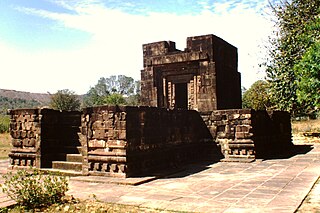
Nachna Hindu temples, also referred to as Nachana temples or Hindu temples at Nachna-Kuthara, in Panna district, Madhya Pradesh, India are some of the earliest surviving stone temples in central India along with those at Bhumara and Deogarh. Their dating is uncertain, but comparing their style to structures that can be dated, some of the Nachna temples are variously dated to the 5th- or 6th-century Gupta Empire era. The Chaturmukha temple is dated to the 9th century. These temples illustrate a North Indian style of Hindu temple architecture.

Bhumara Temple, sometimes called Bhumra, Bhubhara or Bharkuleswar, is a 5th or 6th-century Gupta era Hindu stone temple site dedicated to Shiva near Satna, in the Indian state Madhya Pradesh. The temple has a square plan with a sanctum and Mandapa. While much of it is in ruins, enough of the temple structure and works of art have survived for scholarly studies. The temple is notable as one of the early examples of an architecture that included an enclosed concentric pradakshina-patha. Like other early Gupta era Hindu temples, it includes a decorated entrance to the sanctum flanked by Ganga and Yamuna goddesses, and intricately carved sculptures.
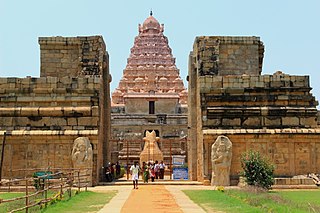
The Brihadisvara Temple is a Hindu temple dedicated to Shiva in Gangaikonda Cholapuram, Jayankondam, in the South Indian state of Tamil Nadu. Completed in 1035 AD by Rajendra Chola I as a part of his new capital, this Chola dynasty era temple is similar in design, and has a similar name, as the older 11th century, Brihadeeswarar Temple about 70 kilometres (43 mi) to the southwest in Thanjavur. The Gangaikonda Cholapuram Temple is smaller yet more refined than the Thanjavur Temple. Both are among the largest Shiva temples in South India and examples of Dravidian style temples. The temple is also referred to in texts as Gangaikonda Cholapuram Temple or Gangaikondacholeeswaram Temple




















